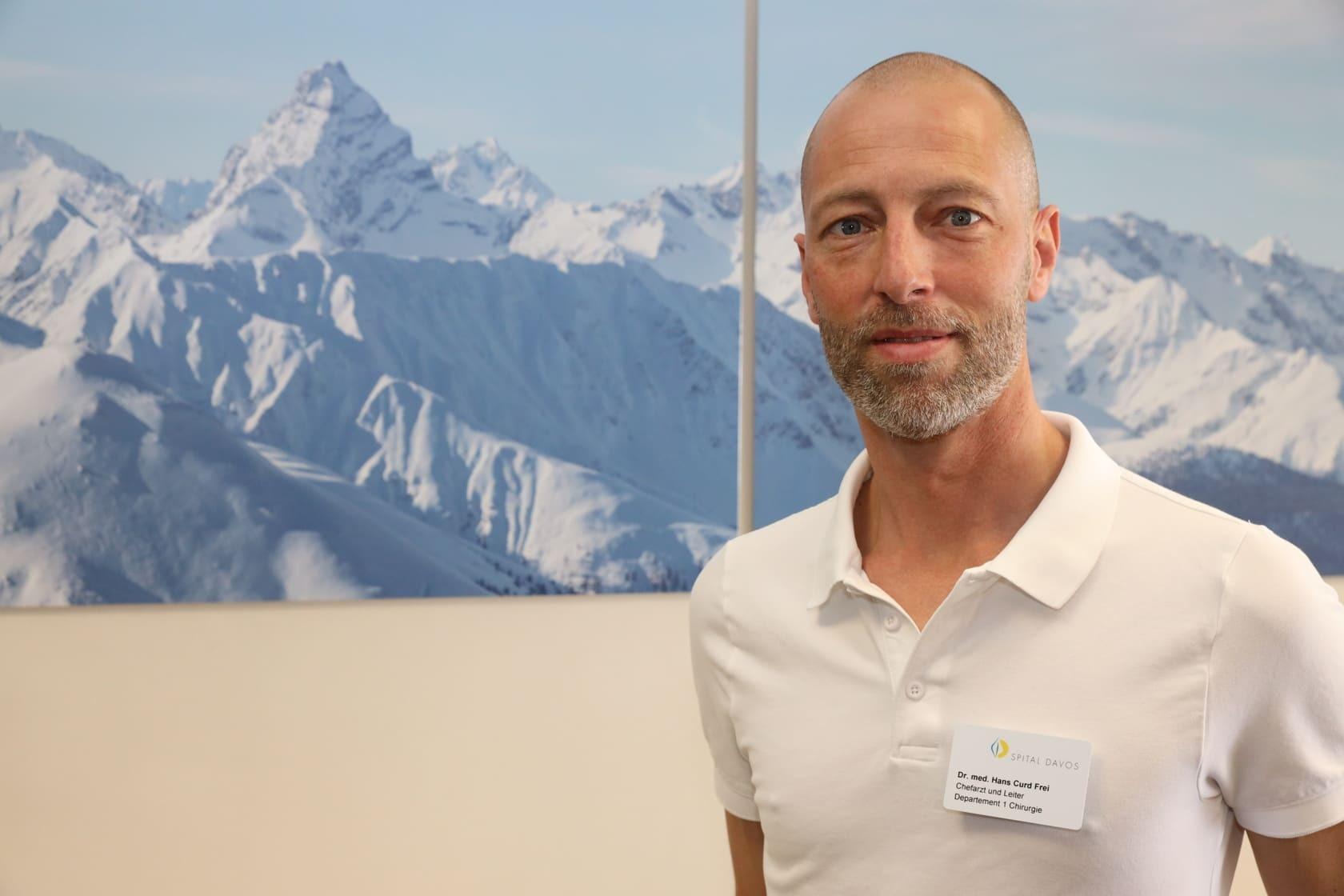CAN YOU TELL US A LITTLE BIT ABOUT YOUR CAREER UP TO DATE AND WHAT BROUGHT YOU TO DAVOS HOSPITAL?
I’m not originally from Davos – I was born in Schindellegi in the canton of Schwyz. After I obtained my MD, I started my career at the Cantonal Hospital in Winterthur (KSW). I was a senior attending physician of the Department of Orthopaedics and Traumatology by the time I left KSW for Davos in 2013. Working at Davos hospital was a dream come true – for an orthopaedic surgeon, it is without a doubt one of the most exciting places to work in. Because of the rich tradition of the AO Foundation in Davos, for one, and because it is a prime destination for sports and mountain enthusiasts from all over the world – not only, but especially during the winter.
WINTER IS YOUR BUSIEST SEASON?
Yes, absolutely. In fact, of all the Swiss hospitals, Davos deals with the highest seasonal variation in terms of hospital admission rates. Right now, our emergency department treats about 70–80 patients a day, versus an average of only 10 in the off-season.
WHEN DOES THE WINTER SEASON USUALLY START?
By mid-December, the slopes are usually in good condition, but things start to heat up right after Christmas. Because of the World Economic Forum, there are fewer tourists in town at the beginning of January; afterwards, the season kicks into full swing until mid-April. Then, from April to June, before the summer season starts, Davos is completely empty.
HOW DOES DAVOS HOSPITAL DEAL WITH THE INFLUX OF PATIENTS OVER THE WINTER MONTHS?
For one, we manage to bridge the seasonal variation with an increased number of residents – a total staff of 11 in the winter versus 8 in the summer that also work the interdisciplinary emergency department. Those fluctuations are possible because we issue eighteen-month rather than yearly contracts. We do add one or two seasonal hires that mainly work in the emergency department. On my surgical team, there are currently 7 residents versus 4 in the summer. Also, there are always two attending physicians – one in the OR and one on call in the ED. Plus, any vacations, continuing educations and trainings are postponed until after the high season. Our emergency department is extremely well-organized – waiting times are short, and decisions are made very quickly. Furthermore, we have two operating rooms, both of which are used to full capacity right now. As a consequence, we perform very few elective surgeries during the winter season.
WHAT ARE SOME TYPICAL INJURIES YOU SEE IN THE COLDER SEASON, POSSIBLY RELATED TO WINTER SPORT ACTIVITIES?
For skiers, I would say about thirty percent are knee injuries involving one or multiple ligaments or the tibial head. Many snowboarders and skiers also present with radius or clavicle fractures. Also common are pilon, ankle or calcaneus fractures incurred by sledding or falls on ice. There have been many complex cases – this winter, we have seen an unusually high number of tibia fractures and quite a few badly fractured tibial heads.
DO YOU RECALL A PARTICULARLY INTERESTING CASE YOU WOULD LIKE TO SHARE?
I do remember one patient I performed surgery on exactly one year ago – she presented with a multiligamental knee injury: torn anterior, posterior and inner ligaments, as well as torn medial and lateral meniscus. She used to come in for check-ups, taking the long journey from Berlin to Davos. She just wrote to me this morning — last summer she apparently went back to climbing 6,000 m peaks.
THAT MUST BE GREAT TO HEAR. Absolutely, especially since we never get to see about a third of our patients again. Many of them live abroad and don’t return to Davos for postoperative check-ups.
CONSIDERING THE INJURIES YOU REGULARLY TREAT IN THE OR – ARE THERE CERTAIN WINTER SPORTS YOU YOURSELF TEND TO AVOID?
Yes, as a matter of fact: I don’t ski anymore. We see so many complex knee injuries and tibia fractures with skiers – I assume mostly related to the modern carving skis acting as a lever arm. Maybe that’s why I have decided to stick with snowboarding.
*This interview was conducted on 9 February 2022.
06.04.2023 / company news
→ Back To All NewsA LOOK BACK ON THE WINTER SEASON AT DAVOS HOSPITAL
To conclude this year’s winter season, we took the opportunity to talk to Hans-Curd Frei, MD, Head of the Department of Surgery at Davos hospital, Switzerland.*

Hans-Curd Frei, MD, Head of the Department of Surgery at Davos hospital and member of the Bonebridge Technical Commission
